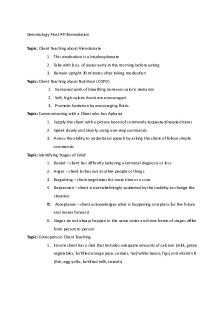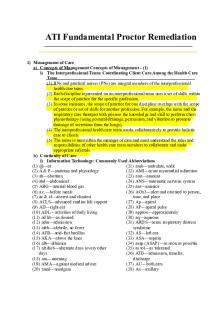NUR 232 ATI Remediation PDF

| Title | NUR 232 ATI Remediation |
|---|---|
| Author | SIMEON IWEKA |
| Course | Advanced Principles of Intervention |
| Institution | Indiana Wesleyan University |
| Pages | 7 |
| File Size | 88.6 KB |
| File Type | |
| Total Downloads | 11 |
| Total Views | 168 |
Summary
ATI Remediation...
Description
RN ATI Fundamentals
Remediation
Management of Care
Chapter 2 Concept Management -The Interprofessional Team: Coordinating Client Care Among the Health Care Team
Nurse-provider collaboration should be fostered to create a climate of mutual respect and collaborative practice Collaboration occurs among different levels of nurses and nurses with different areas of expertise Collaboration should also occur between the interprofessional team, the client, and the client's family/significant others when an interprofessional plan of care is being developed Collaboration is a form of conflict resolution that results in a win-win solution for both the client and health care team Chapter 3 Advocacy-Ethical Responsibilities: Demonstrating Client Advocacy
Ethical dilemmas are problems that involve more than one choice Ethical decision-making is a process that requires striking a balance between science and morality Moral distress occurs when the nurse is faced with a difficult situation and their views are different Chapter 4 Client Rights - Legal Responsibilities: Nursing Role While Observing Client Care The nurse needs to make sure that the patient to understand the care to be able to be active in decision making. The nurse needs to make sure that the patient understands their rights. The nurse protects the patient’s rights, especially when they cannot.
Chapter 4 Inform Consent - Legal Responsibilities: Responding to a Client’s Inquiry About Surgery Nurse witness informed consent Client must receive adequate information to make a decision Provider must give other options for treatment along with the option of refusal Chapter 5 Continuity of Care - Information Technology: Commonly Used Abbreviations SOAP PIE DAR focus charting Chapter 5 Information Technology - Information Technology: Receiving a Telephone Prescription Best to avoid but sometimes unusual emergency may require it Have a second nurse listen in Repeat it back Question any prescription that look in appropriate for the client Make sure provider signs it within 24hours
Safety and Infection Control Chapter 28 Head and Neck: Performing the Weber’s Test
Use vibrating tuning fork of top of head Ask if they can hear it one ear (left or right) or both Should be negative= they hear in both ears
Basic Care and Comfort Chapter 41 Non-Pharmacological Comfort Interventions - Pain Management: Suggesting Nonpharmacological Pain Relief for a Client Teach patient about relaxation techniques to deal with pain. Distraction techniques include ambulation, deep breathing, television, music and visitors. Use heat and cold applications to stimulate the skin. Ensure clean and smooth linens and anatomic positioning Chapter 57 Nutrition and Oral Hydration-Fluid Imbalances: Calculating a Client’s Net Fluid Intake Monitor I&Os Monitor edema Encourage mobility
Physiological Adaptation Chapter 12
Alteration in Body System - Client Safety: Priority Action When Caring for a Client Who is Experiencing a Seizure During active seizure lower client to the floor and protect head Maintain airway Pad side rails Chapter 53 Alteration in Body System - Airway Management: Performing Chest Physiotherapy Loosen respiratory secretions For patients who have thick secretions and unable to clear Contraindicated for patients who are pregnant Health Promotion and Maintenance Chapter 25 Aging Process - Older Adults (65 Years and Older): Teaching About Manifestations of Delirium Acute First manifestation of infection usually UTI Decline in cognitive function
Chapter 37 Health Promotion/Disease Prevention - Hygiene: Bathing a Client Who Has Dementia
Understand patient’s ability to perform hygiene care Allow patient to do what they can Apply lotion and change gown and sheets Chapter 49 Pharmacological and Parenteral Therapies - Intravenous Therapy: Promoting Vein Dilation Prior to Inserting a Peripheral IV Catheter Use gravity Friction or heat Fist clenching Reduction of Risk Potential Chapter 43 Therapeutic Procedure - Bowel Elimination: Discharge Teaching About Ostomy Care Preferably a wound ostomy nurse educates Inspect stoma and cleanse skin Apply paste and barrier and new bag Chapter 53 Lab Value - Airway Management: Collecting a Sputum Specimen To identify aberrant cells or cancer To diagnose TB Wait 1-2 hours after patient eats to obtain specimen Chapter 54
Potential for Complications of Diagnostic Tests/Treatments/Procedures - Nasogastric Intubation and Enteral Feedings: Evaluating Placement of a Nasogastric (NG) Tube) Placement should be verified by x-ray. Do not inject air into the abdomen and auscultate. If the tube is not in the stomach advance 5 cm and re-evaluate placement....
Similar Free PDFs

NUR 232 ATI Remediation
- 7 Pages

ATI Remediation
- 9 Pages

Peds ATI Final Remediation
- 3 Pages

NUR 215 ATI
- 9 Pages

Gerontology ATI Remediation 1
- 2 Pages

Peds ATI remediation
- 9 Pages

ATI Maternal Newborn Remediation
- 22 Pages

APGAR Testing - ATI Remediation
- 1 Pages

Mental Health ATI Remediation
- 3 Pages

ATI Proctor Fund Remediation
- 25 Pages

ATI Remediation FOR Fundamentals
- 9 Pages

Maternal ati remediation
- 6 Pages

Maternity ATI 3point remediation
- 3 Pages

Med Surg ATI Remediation
- 6 Pages
Popular Institutions
- Tinajero National High School - Annex
- Politeknik Caltex Riau
- Yokohama City University
- SGT University
- University of Al-Qadisiyah
- Divine Word College of Vigan
- Techniek College Rotterdam
- Universidade de Santiago
- Universiti Teknologi MARA Cawangan Johor Kampus Pasir Gudang
- Poltekkes Kemenkes Yogyakarta
- Baguio City National High School
- Colegio san marcos
- preparatoria uno
- Centro de Bachillerato Tecnológico Industrial y de Servicios No. 107
- Dalian Maritime University
- Quang Trung Secondary School
- Colegio Tecnológico en Informática
- Corporación Regional de Educación Superior
- Grupo CEDVA
- Dar Al Uloom University
- Centro de Estudios Preuniversitarios de la Universidad Nacional de Ingeniería
- 上智大学
- Aakash International School, Nuna Majara
- San Felipe Neri Catholic School
- Kang Chiao International School - New Taipei City
- Misamis Occidental National High School
- Institución Educativa Escuela Normal Juan Ladrilleros
- Kolehiyo ng Pantukan
- Batanes State College
- Instituto Continental
- Sekolah Menengah Kejuruan Kesehatan Kaltara (Tarakan)
- Colegio de La Inmaculada Concepcion - Cebu

